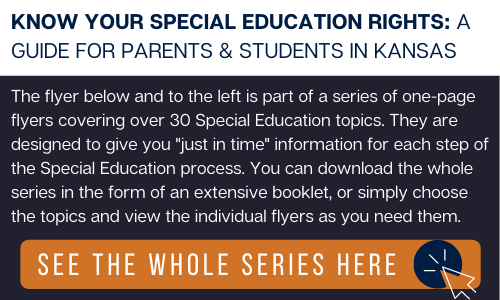How does my child qualify for an IEP?
 |
 |
PDF Version: How does my child qualify for an IEP?
Versión en Español en Formato PDF: ¿Cómo Califica Mi Hijo Para un IEP?
In order to qualify for an IEP and Special Education your child would have to have an evaluation done by the school. Not every child with a disability has an IEP (Individualized Education Program). Either the parent or the school can make a request for the evaluation. If the school thinks an evaluation is needed, they must give the parents what’s called a Prior Written Notice. This tells parents what the school plans to do in the evaluation and why. There are rules on what this notice must include.
The evaluation will likely include observations, parent input, a review of existing information, and formal tests. A student who is 18 or older can also request their own evaluation.
See the rules on what a Prior Written Notice must include on page 35 of the Kansas Special Education Process Handbook.
How do I request an evaluation?
Make the request in writing. It can be an email or a paper letter. Keep a copy.
Describe what’s going on with your child. Tell them about your child’s disability and needs. Be clear about your concerns. Example: if your child is struggling with homework, or has behavior issues, be sure to include that in your written request.
Read the document at the link below that describes the eligibility indicators for Special Education. These indicators show you which category or categories fit your child best. When you make your written request, tell the school which eligibility indicators your child qualifies for and why.
The school must respond in writing within 15 school days of your request for an evaluation. The school must let you know whether or not they will do an evaluation. They must also let you know what they based their decision on.
The entire process of the evaluation must be completed within 60 school days of your written consent to initiate the evaluation. This request for your written consent will come in the form of a Prior Written Notice. Within this 60 school day timeline several things must happen. This includes the school doing the evaluation, bringing the school and parent together to review the results and make an eligibility decision, putting an IEP (Individualized Education Program) in place, and starting Special Education Services. If you need additional help understanding this process, feel free to contact Families Together and the Disability Rights Center of Kansas.
I requested an evaluation for my child, but the school refused. What can I do now?
The school may refuse an evaluation. They must provide you a Prior Written Notice that says why they refused. If you still want your child to be evaluated, these are some things you can do:
• Request a meeting with the school to talk about it.
- Make this request in writing.
- Ask the school to explain why they are refusing the evaluation. If the school says they have data and information explaining their decision, have them to provide it to you.
• If someone outside the school has either done an evaluation or has information that relates to your child’s eligibility, you should share that with the school.
• Call Families Together at 800-264-6343 or visit familiestogetherinc.org.
- They can give you free information on Special Education in Kansas.
• Call the Disability Rights Center of Kansas at 877-776-1541 or visit drckansas.org.
• Request mediation if nothing else has worked.
• You can request a due process hearing if mediation is not an option (see the Dispute Resolution link to the right).
Sources & Additional Resources:
Kansas Special Education Process Handbook. Kansas State Department of Education.
Dispute Resolution. Kansas State Department of Education.
Parent’s Guide to Special Education. Families Together, Inc.
What is an IEP? Disability Rights Center of Kansas & Families Together, Inc.
Who can make a referral for an evaluation to see if my child needs Special Education services? Disability Rights Center of Kansas & Families Together, Inc.
Disclaimer: This fact sheet is not intended to provide specific legal advice. If you need legal advice, please contact an attorney. Only an attorney can give you specific legal advice based on your particular situation. We try to update our materials regularly, but the law can change frequently. This publication is based on the law at the time that it was written. Future changes in the law could make information in this fact sheet inaccurate.
.png)





